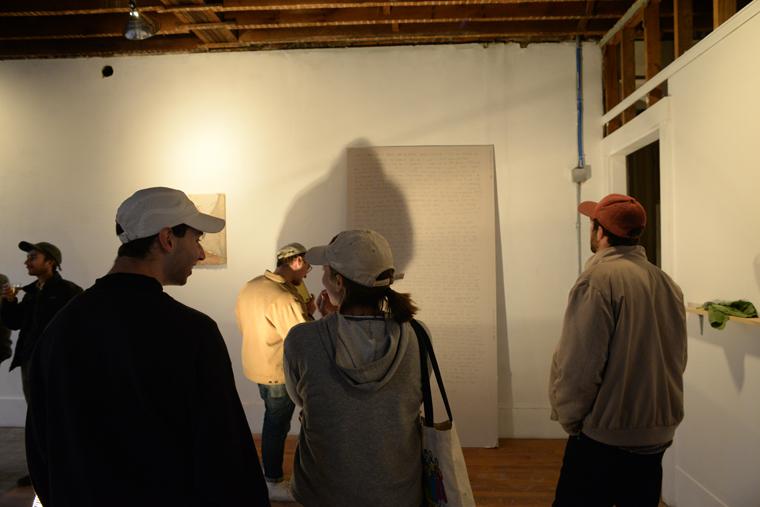Putting Student Art in the Spotlight
May 4, 2015
Sky Kalfus

Storage hosts Soft Defense, a senior studio exhibit by Aria Dean.
Photo credit: Jeong Hyun Hwang
It’s a chilly Friday night in Oberlin, and students are congregating in a parking lot next to a Dumpster. They’re preparing to see an art show at Storage, a student-led art gallery marked by a heavy metal door tucked amid Oberlin’s main drag of shops and restaurants. Inside the gallery, student art hangs on clean white walls. At the front stands a makeshift bar where students can purchase Storage tote bags or help themselves to cheese and, for those of-age, a glass of wine. Opened this year by seniors Aria Dean and Casey Silverstein, Storage is one of several venues where students are sharing their art with other students.
There’s no shortage of student artists at Oberlin. But until recently, there were few outlets for students, even studio art majors, to display their art. “If you are in the art department, you can show your work twice a year at Art Walk, and then you get your Senior Studio,” explains Dean. “There is a lack of opportunities and space in the department to show your work.” The options were even slimmer for students outside of the art department. But in the past several years, organizations like Storage and the Exhibition Initiative, as well as events like the Computer Science Art Show, have worked to create additional spaces for students from every discipline to share their work in a gallery-like setting.
Exhibition Initiative (ExI) is a student-run organization that curates student art exhibits at Storage, Fischer Gallery, and other spaces around campus. This past December ExI made an open call for students’ zines (self-published books of art and poetry), which it curated and displayed at Storage. ExI displayed more than 20 zines, which sat propped up on shelves so viewers could flip through them at their leisure. Many of the zines were provided by the Oberlin Comics Collective, a student-run small press. Currently, ExI is working on its spring exhibition, “Post-Internet is Dead!” using an open call over Facebook to collect material.
Besides collaborating year-round with groups such as ExI and even hosting senior studio shows during the month of April, Storage also uses its space to bring visiting speakers and create a dialogue with outside artists. “We want to create a connection between the Oberlin art bubble and the larger world,” says Dean. Recently, Storage hosted a lecture by digital art curator Lindsay Howard, a New York-based artist who curated the first digital art auction.
While ExI and Storage are both outgrowths of the art department community, students in computer science are also organizing venues for more interdisciplinary art. Students annually organize The Computer Science Art show, which focuses on computer science-themed visual art. Anyone can have their work displayed; in the past, even professors have participated.
Computer Science major Eli Rose ’15 is planning a projected light show based on Conway’s Game of Life, a famous digital simulation of cellular behavior. The program will be “sparkle-ified and hopefully synced up to music,” says Rose. “It’s a very simple program that, when iterated a thousand times, interacts with itself to create surprisingly intricate and what I would call beautiful results.” The organizers, fourth-year students Paul Buser and Samantha Mater, say they hope to reach people who might not otherwise be drawn to computer science. Rose expresses similar goals. “It’s a way to change people’s expectations about computer science and a way for me to show some of the beauty and enjoyment that I get out of it,” he says.
There’s no question that Oberlin students are making art on every corner of the campus, and with events such as the Computer Science Art Show, students who may not identify as artists have a space to come forward and express themselves. Meanwhile, student groups like ExI and Storage are also responding to students' desires to share their art on campus and engage in creative dialogues with their peers. “We have a lot of ideas about art, and we’re not the only ones on campus thinking about these things,” says Dean. “We want to have an ongoing conversation.”
You may also like…
Josh Nolan Named Vice President, General Counsel, and Secretary at Oberlin
Distinguished attorney brings extensive experience in higher education law.
Learning by Teaching: Oberlin Students Share Global Music with Young Learners
College and Conservatory students in PACE 103 prepare local children for an immersive community concert at Oberlin.
Nuiko Wadden ’02 Joins Oberlin Conservatory Faculty as Assistant Professor of Harp
The versatile musician brings extensive opera, orchestral, and contemporary music experience to her role


